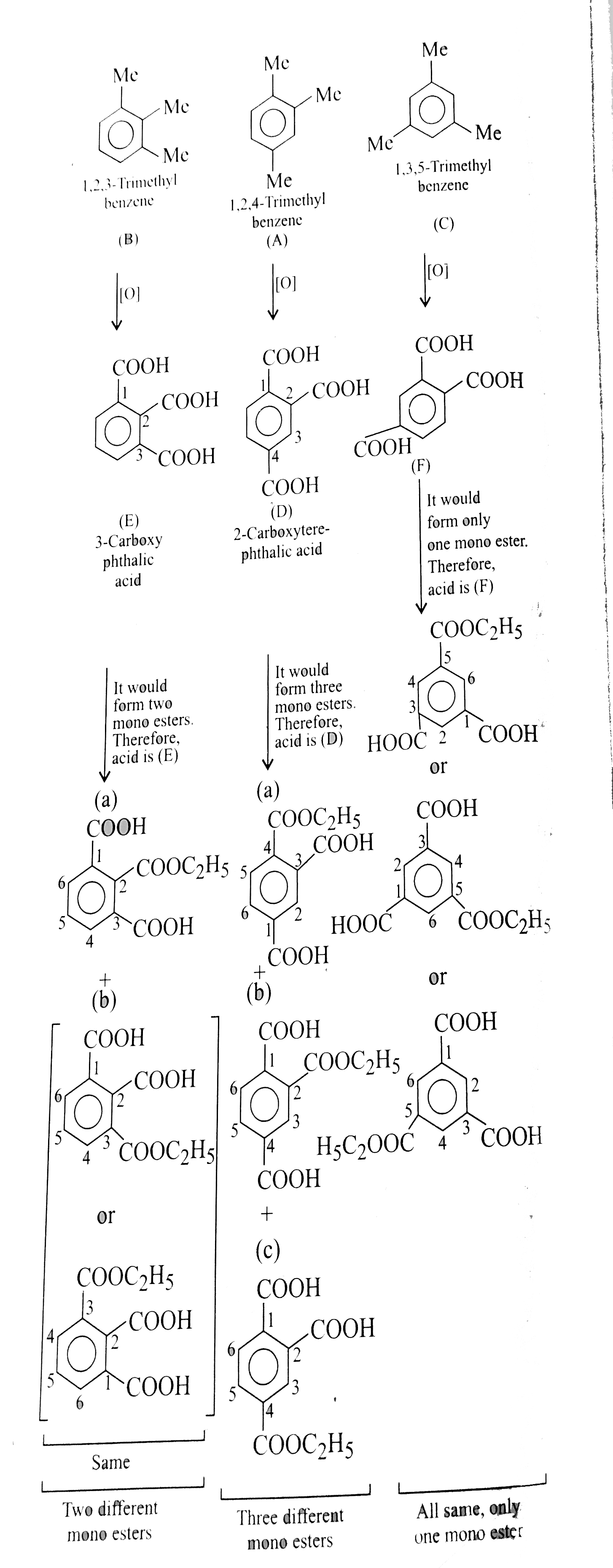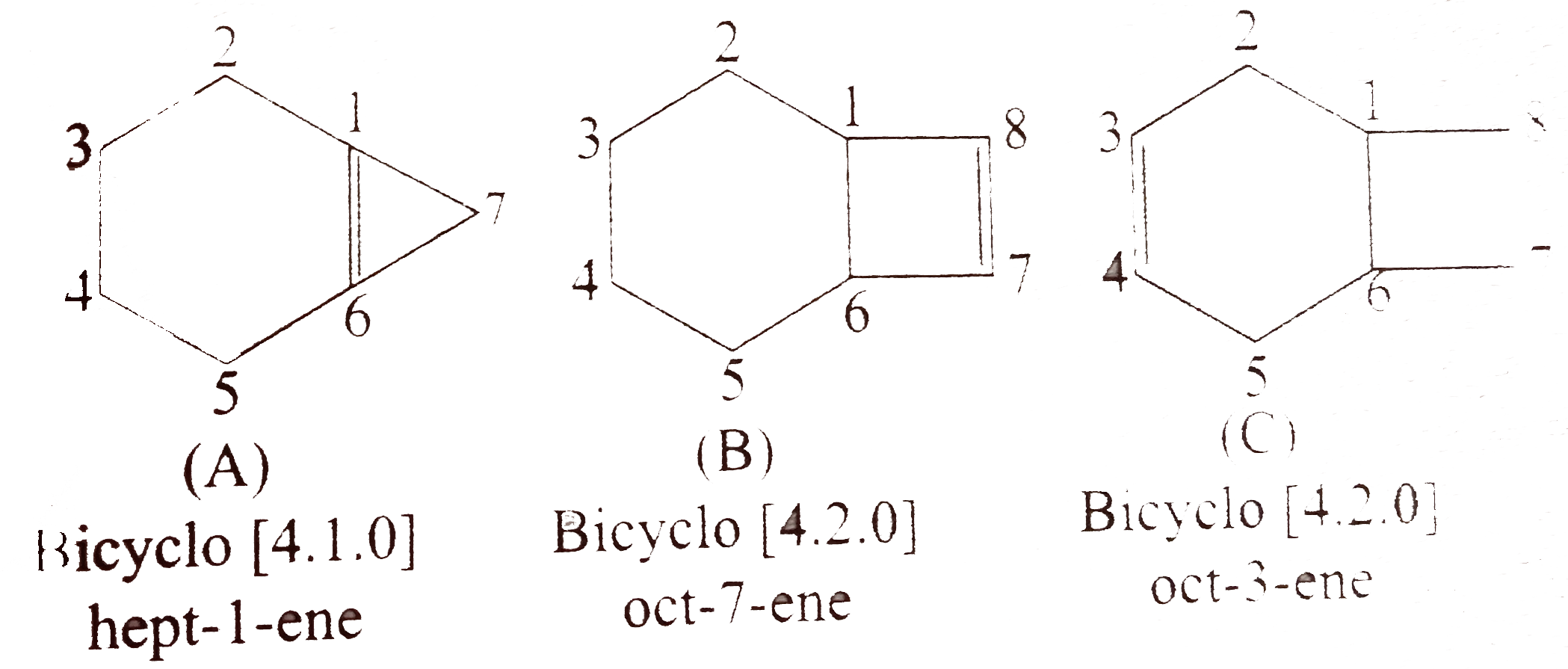Three isomeric hydrocations C9H12⎡⎢⎣ABC⎤⎥⎦ oxide to C9H6O6⎡⎢⎣DEF⎤⎥⎦ while (D) may give three different monoethyl esters, (E) may from only two and (F) only one. Idenity compounds (A) to (F).
D.U in C99)H12=(2nC+2)−nH2
=(2×9+2)−122=4∘
4D.U suggets that it contains benzene ring. On oxidiation (A),(B), (C) give C9H6O6, whicvh suggests three (COOH) groups. Therefore (A),(B),(C) contain three (Me) groups whicvh on oxidation give three (COOH) groups. The three isomers of C9H12 are:

Topper's Solved these Questions
- AROMATIC COMPOUNDS AND ALKYL AND ARYL HALIDES BOOK - CENGAGE CHEMISTRYCHAPTER - AROMATIC COMPOUNDS AND ALKYL AND ARYL HALIDES EXERCISE - Exercises Concept Application Type
2 Videos
- AROMATIC COMPOUNDS AND ALKYL AND ARYL HALIDES BOOK - CENGAGE CHEMISTRYCHAPTER - AROMATIC COMPOUNDS AND ALKYL AND ARYL HALIDES EXERCISE - Exercises Concept Application
4 Videos
- AROMATIC COMPOUNDS AND ALKYL AND ARYL HALIDES BOOK - CENGAGE CHEMISTRYCHAPTER - AROMATIC COMPOUNDS AND ALKYL AND ARYL HALIDES EXERCISE - Exercises Subjective Type
4 Videos
- APPENDIX INORGANIC VOLUME 2BOOK - CENGAGE CHEMISTRYCHAPTER - APPENDIX INORGANIC VOLUME 2EXERCISE - Short Answer Type
179 Videos
- BIOMOLECULESBOOK - CENGAGE CHEMISTRYCHAPTER - BIOMOLECULESEXERCISE - Exercises Archives (Analytical And Descriptive)
8 Videos
Similar Questions
Compound C8H9Cl(A) on treatment with KICN followedd by hydrolysis gives C9H10O2(B). Ammonium salt of (B) on dry disillation yiels (C), wyhich reacts with alkene solution of bromnine to give C8H141N(D). Another compound C8H10O(E) is obtained by the actions by the action of nitrous acid of (D) or by the action of aqueosu potacsh on (A),(E) on oxidation gives the inner anthydide C8H6O4(F) which gaves the inner anthdride C8H4O3(G) on heating Identify the various compounds (A) to (G).
View SolutionAn organci compound C6H4O2NCl(A) reacts with a,la,oo tp gove C6H5O3N(B). On reduction with tin and HCl,(B) gives C6H7ON(C) whereas on milder reduction it gives (D)C6H7O2N, which rearranges in the presence of a mineral acid to give a new compound (E). Identify the various compounds from (A), to (E).
View Solution
Knowledge Check
The three compounds (A),(B),and (C) on hydrogenation with H2+Pd give (D),(E) and (F), respectively.

Compounds (D),(E) and (F) are :A B
B C
C D
D
ON disuphonatioon followed by fusion with NaOH an dacidificant, an aromatic compound C8H10(A) gives two isomeric comnpounds (B) and (C) (molecular formula C8H10O2. Oxidation of esters of (B) and (C) followed by hydrolysis gives two isomers comnpounds (D) and (E)(C7H6O4) which may be decarboxylated to form C6H6O2(F). Identigy compounds (A) to (F).
View SolutionThe three compounds (A),(B),and (C) on hydrogenation with H2+Pd give (D),(E) and (F), respectively.

Compounds (D),(E) and (F) are :
View SolutionOn nuclear chlorination, C8,H10(A) gives a product (B) which may be oxidised to C8H5O4Cl(C).(A) may alos be chlorinated to give C8H8Cl2(D),C8H6Cl4(E), and C8H4Cl6(F).(D),(E) and (F) on hydrolysis give halogen-free compounds (G),(H), and (I), respectively. With CrCO2Cl2,(A) gives C8H6O4 which is identiacla with (I) . Identify wtih (I). Identify the varioius compounds (A) to (J).
View SolutionOn nuclear chlorination, C8,H10(A) gives a product (B) which may be oxidised to C8H5O4Cl(C).(A) may alos be chlorinated to give C8H8Cl2(D),C8H6Cl4(E), and C8H4Cl6(F).(D),(E) and (F) on hydrolysis give halogen-free compounds (G),(H), and (I), respectively. With CrCO2Cl2,(A) gives C8H6O4 which is identiacla with (I) . Identify wtih (I). Identify the varioius compounds (A) to (J).
View SolutionAn organic compound (A) (C5H7OCl) reacts rapidly with ethanol to give (B) (C7H12O2). (A) also reacts with water to produce an acid which reacts with bromine to give (C ) (C5H8Br2O2). (B) on boiling with H2SO4 forms an acid (D). When (D) is oxidised with KMnO4 an acid (E ) (C4H6O3) is produced. On mild heating, (E ) gives (F) (C3H6O) which cannot be oxidised by ammoniacal AgNO3. Identify the compounds (A) to (F).
View SolutionAn organic compound (A) (C5H7OCl) reacts rapidly with ethanol to give (B) (C7H12O2). (A) also reacts with water to produce an acid which reacts with bromine to give (C ) (C5H8Br2O2). (B) on boiling with H2SO4 forms an acid (D). When (D) is oxidised with KMnO4 an acid (E ) (C4H6O3) is produced. On mild heating, (E ) gives (F) (C3H6O) which cannot be oxidised by ammoniacal AgNO3. Identify the compounds (A) to (F).
View SolutionAn organic compound C8H10 (A) on treatment with alkaline KMnO4 gives a compound C6H6O4. (B) which on strong heating gives C6H4O3 (C). The compound (D) in dry benzene in presen of AlCl3 gives compound (E). The compound (E) on treatment with PCl5 followed by reaction with H2/Pd,BaSO4 gives compound (F). Identify (A) to (F).
View Solution
